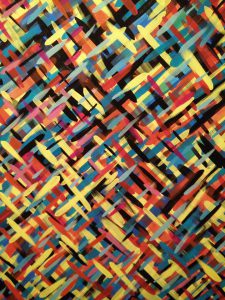スキマ、言葉、考える事。 The gap, the language, the thinking. (2017)

スキマ、言葉、考える事。
- 考えるということは、言葉やイメージを紡ぐと言う事。もやっとした印象が、ある枠組みを持つこの瞬間を言語化と考えれば、言葉だけではなくてイメージとして捉える事も言語と言える。
- イメージと言葉は、意味するものと意味されるものとして必ずしも完全に一致しない。それぞれは独立したもので切断可能な関係性によって接続されている。「四角い丸」という言葉は成立するが、そこにイメージは対応できない。
- ヴァルター・ベンヤミンは、「物質の言語」という概念を使って、物質による人間の感覚に対する訴えかけを表現した。言語学者ウィリアム・ラボフはテープレコーダを使ったフィールド・ワークで、言語の物質性を浮かび上がらせた。
- ラテン語から無数の方言として派生したヨーロッパ言語は、それぞれが異なる言語を話しているとは気付かぬまま、地図の上に広がる緩やかなグラデーションの様な多様性を作り上げた。17世紀の国家近代化の中で、辞書や標準語といった装置によって意味と言葉が恣意的に結晶化されるまでは。
- 英語と、日本語を切り替えながら使っていると、それらのちょうどスキマ、ちょうどいいところに言いたい事が隠れていてどうしても言えない事に気がつく。当たり前だけど日本語では日本風に、英語では西洋風に「いい感じ」に仕上がるけど、「自分風」はそのスキマに存在する。
- 僕らが考えずに受け入れてしまっている現代社会の数々の前提。刻印された力の根本条件を問うという事は、まず考えるためのプロセスである言語という概念を掘り返す事から始まるのではないだろうか。
- 哲学者ジョルジオ・アガンベンは終着点のない、つまり特定の意味を持たなくなった身体の動きがジェスチャであると言う。そして、ジェスチャとしてのダンスは身体の様々な動き・物質性を意味から解放し、我々の眼前に初めて「そのもの」を提示するがゆえに驚愕に値する。そういった驚愕をもたらすモノを、アートと呼ぶ。
- 言葉とイメージは補完しあって言語として機能する。ただしこれらは、単に意味するもの/意味されるものという固定された関係に収束する事は出来ない。この二者の間で空間・時間といった抽象的なパラメーターを司るのがコレオグラフィーであり、ドゥルーズ/フーコーの言うダイアグラム、カントにおけるスキマ(Schema)に該当する概念であると考える。
- 僕は、コレオグラフィーは知を表面化するための概念だと思っている。そして世界を動かす力(potentia)としての知を浮かび上がらせるために、コレオグラフィーを使って言語〜思考〜物質性の織りなす広大な可能性(potentiality)を明らかにする事が、一つの手段だと考えている。
2017年4月 児玉北斗
“The gap, the language, the thinking.”
- Thinking involves images or words. The moment hazy impression takes a form, there is language. So not only words, but imagination can be considered as language?
- Image and word cannot be reduced to mere signified and signifier. They are independent entities connected with the relationships that are always possible to disconnect. One can say “Square circle” and perfectly make sense, but there is no image to correspond.
- Walter Benjamin invented the concept “language of things” to depict the allure of material being to human perception. Socio-linguist William Labov prove the materiality of language through his field research, using tape recorders.
- Many european languages derived from Latin without being aware of its process, and created smooth gradation of multiplicity on the map of language. This was not the case, once those languages were crystallised by the standard dialect or dictionaries, in the midst of modernisation process in the 17th centuries.
- When I code-switch between English and Japanese, it’s evident that what I really mean is exactly in between those languages. In that gap. Japanese word for the gap is sukima. What? Schema?
- We tend to automatically accept presuppositions of current society, without even thinking. To question the conditions of inscribed power means to reconsider the fundamental concept of the act of thinking: Language.
- Philosopher Giorgio Agamben says that gesture is “a means without end”. And dance as a gesture frees movement and materiality of the body from fixed purpose, exhibiting pure physicality. We see “what that really is” for the first time, thus this encounter is astonishing. This is what we call art.
- Words(discursive) and image(non-discursive) complements each other to function as language. However, they cannot be reduced to fixed relationship as in signifier/signified. Choreography deals with spacio-temporal parameters between these two to form a sort of knowledge, and I think this understanding of choreography is exactly what Deleuze and Foucault means by ”abstract machine” or “diagram”, therefore, Kant’s ‘Schema’.
- For me, “choreography” is a concept for knowledge. It can shed a light on the potentiality that arise from Material-Language-Thinking relationship. Hopefully it forms and enriches knowledge as the power to move the world (potentia), not the power to control the others (potestas).
April 2017, Hokuto Kodama